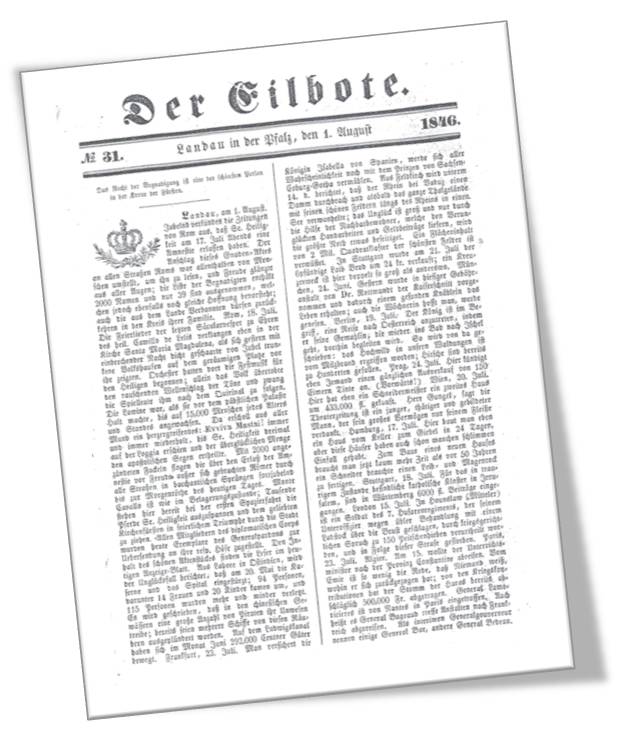The temblor
St. Goar - July, 29th, 1846
In the streets, however, nothing was felt. Today, marketers reported similar events from all over the mountain. According to our tower keeper, the entire region of Landau seemed rather lively. Lights were lit and it was evident that the shaking of the earth had also been noticed in the Gleisweiler public bath, supposed that it was not a light occurrence, as some claim. There were rumors of houses tumbling down in Ramberg and Willgartswiesen and of a powder magazine explosion in Strasbourg - but, thank God, none of it was true.
Landau Weekly – No. 32 – Wednesday, August 5th, 1846
Micellaneous.
A site note on the reactions the recent earthquake received in the Mainz yellow press: One might be tempted to believe that the recent phenomenon was related to the general atmospheric conditions that determined our weather in the past weeks, such as sweltering heat, water shortage, smoky skies, more or less still air and the like. Let us therefore turn to Alexander of Humboldt’s Cosmos, where he writes the following: “That kind popular belief — which is much less common in countries where earth tremors occur with frequency than in those where this kind of phenomenon is rather rare, such as in southern Europe — has been refuted by my own observations as well as by the experiences of all of those who have lived for many years in regions where, as in Cumana, Peru or Chile, the ground moves often and violently. I have experienced earthquake shocks in sunshiny weather and fresh easterly winds but also in rain and stormy weather; and neither the compass needle nor the air pressure had given any previous indication about what was to happen.” Temblors are a sign of the forces that act inside our earth and push towards its surface; and they often times occur in connection with the eruption of a volcanic mountain, insofar as the elements brewing inside of it can find their way to the surface. If this is not the case, part of the earth’s crust is uplifted and new mountains are formed, which, when rising above the ocean, create new islands, etc. The greatest discoveries of modern geology reveal details about the processes within the earth’s interior. Earth tremors often times propagate from the epicenter over distances of more than thousand miles, which explains why the heavy earthquake that destroyed Lisbon on November 1st, 1755 was felt miles away in the Alps, on the Swedish coast, in the Antilles, in Canada’s Big Lakes, in Thuringia and Northern Germany. In its aftermath, the Teplitz mineral well ran dry and the ocean rose 60 feet in Cadir. The area affected by the quake was four times the size of Europe. The propagation of shockwaves is always dependent on the mountain’s mechanical structure, just as the magnitude of the temblor in adjacent regions is determined by local underground conditions. In some regions earth tremors are rather frequent, and if we had the opportunity for closer observation, we would find that minor earthquakes occur nearly constantly around the world, giving evidence of the continuous seismic activity within the earth’s interior. In these places, man loses his fear of seemingly mysterious natural phenomena, in the same way in which we have grown accustomed to thunder storms. Peruvians have no knowledge of thunder or lightning; no thundercloud has ever darkened their sky. In Peru, thunder only occurs in the interior of the earth. But neither the rolling and cracking nor the shockwaves frighten Peruvians because they know that these kinds of phenomena are rarely dangerous, maybe once or twice in a century. In Lima, for example, minor earthquakes are not more worth attention than a hailstorm would be in temperate zones.
According to the Frankfurt newspaper, the recent earthquake was noticed in many places, mostly on towers and tall buildings; while the allegedly strongest shockwaves were observed in the city of Wiesbaden. The Thiermarkt fountain in Mainz has supposedly run dry and people are concerned the quake may have negatively affected the well. Aside from that, there is no more word on further damage or misfortune in these reports, except for two children who were thrown out of their bed. The poor little ones! To whom might they belong? The parents must be so grateful to the reporter for not making them drown in the Queich river, too. It’s a pity that three additional reports from Landau have been ignored by the Frankfurt newspaper: First, a picket enclosure on the lower gate of a yard was allegedly marveled about itself for not having fallen over. Furthermore, the steeple of the Siebeldingen tower, which had been crooked for many years, was straightened by the quake, and a fellow-countryman, who was sleeping quietly next to his wife, was awakened by the shock and, irate, asking the latter why she had hit him, boxed her on the ear for lying.
Advertiser – Public announcement by the police – No. 33 – Landau, August 15 th, 1846
Landau, August, 12th. The news of Naples’ destruction as a result of the earthquake on the 29th of the previous month has been spreading here and there. It is easy to see this as an obvious bad joke since we cannot possibly know on August 3rd what happened in Naples on July 29th.
City Archive, Landau in the Palatinate

